Geography of Japan
Position of Japan in the world

As in the figure, Japan is located around the eastern edge of Eurasia Continent.
Japan is an island country surrounded by the sea.
Japan is at the northwest edge of Pacific Ocean (太平洋, "Taiheiyou" in Japanese), so the position is just at the boundary of the world's largest continent and the world's vastest ocean.
(The sea to the south of Japan is sometimes called "Philippine Sea" as a part of Pacific Ocean.)
The west side of Japan faces the Sea of Japan (日本海, "Nihonkai" in Japanese).
South Korea, North Korea and Russia are located on the opposite side of the sea.
There is East China Sea (東シナ海, "Higashi-Shinakai" in Japanese) to the southwest of Japan.
China and Taiwan are located on the opposite side of the sea.
In addition, the northeast coast of Hokkaido island faces Sea of Okhotsk (オホーツク海, "Ohôtsukukai" in Japanese) .
Islands of Japan
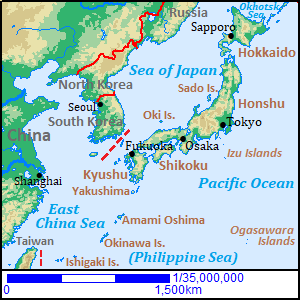
There are four large islands in Japan.
The central island is Honshu (本州) and it accounts for about 60% of the country.
It has an arc shape and the length is about 1,400 km.
The area is a little larger than Great Britain island in the United Kingdom.
Since the ancient time, Honshu has been the center of Japan.
Tokyo (the capital of Japan), Kyoto (the ancient capital), Osaka, Nagoya, Yokohama, Sendai, Hiroshima, etc. These main cities are in the island.
(Because Japanese people recognize it as the mainland of Japan, the word of "Honshu" is rarely used in daily conversation.)
Hokkaido (北海道) island is located to the north of Honshu.
Kyushu (九州) island is just to the southwest of Honshu.
These islands are connected to Honshu by undersea tunnel.
Shikoku (四国) island is the smallest among four islands and is surrounded by Honshu and Kyushu.
It is connected to Honshu by three bridges.
Between Kyushu and Taiwan, there is a row of small islands shaped in an arc.
It is called "Nansei Islands", and the central island is Okinawa (沖縄).
In addition, from the southeastern coast of Honshu to the south, very small islands are dotted on a line.
They are along the deep and long trench in the Pacific Ocean.
Many of them are volcanic islands.
The islands near Honshu are called "Izu Islands".
And some islands located about 1,000 km south of Honshu are called "Ogasawara Islands".
As above, the territory of Japan is surprisingly wide.
By the way, according to Geospatial Information Authority of Japan, the number of islands in Japan is 14,125. (2023)
People live in 421 islands of them.
Japan is a mountainous country
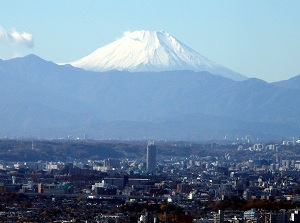
Mount Fuji from an observatory in Tokyo
More than 70 percent of the land of Japan is mountainous.
Kanto Plains is the widest flat area in Japan.
There are Tokyo, Yokohama and many other cities in the area and about one fourth of the population of Japan concentrates in the area.
The area is about 150 km in diameter.
But other plains in Japan is not so wide.
Other big cities such as Kyoto, Osaka, Nagoya, Fukuoka, Sapporo are located in narrower plains.
In fact, we can have a view of mountains in most cities in Japan.
Most of the mountains are 500 to 2,000 meters high, and there are the mountain ranges over 3,000 meters high in the center part of Honshu Island.
And, most parts of the mountains are covered with forests.
Mount Fuji (富士山, "Fujisan" in Japanese) is the most popular mountain in Japan.
It is the highest mountain in Japan and the altitude is 3,776 meters.
Mountain has been a familiar existence for Japanese people, so beautiful mountain had been a subject of faith in any area.
Mount Fuji is a typical example.
So the mountains shaped like Mt.Fuji across the country are usually nicknamed "xxxx-fuji".
There is a mountain range called the Japan Alps in the center of Honshu island.
The mountains have altitudes of over 2,500 to 3,000 meters and are steep but beautiful.
So, they have been loved by mountain climbers since a long time ago.
Volcano and Onsen
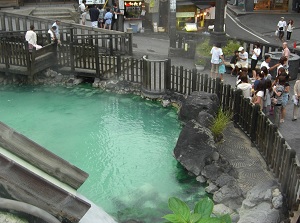
Hot spring pond in Kusatsu Onsen
There are 111 active volcanos in Japan.
It is 7% of all volcanos in the world.
Hokkaido island, east part of Honshu island, Izu Islands, and Ogasawara Islands.
Over 90 active volcanoes are dotted on the long line from north to south.
Mount Fuji is one of the active volcanoes.
Other active volcanos are mainly in Kyushu island and some islands to the south of Kyushu.
We can often see the volcanic smoke of Mount Aso and Sakurajima.
By subterranean heat of volcano, there are a lot of hot springs throughout the country.
More than 3,000 of them have any facility as hot spring resorts.
"Hot spring" is called Onsen (温泉) in Japanese.
Visiting Onsen has been the best leisure for Japanese people since ancient times.
River and Waterfall
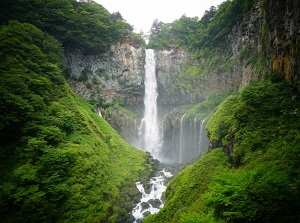
Kegon Falls in Nikko city
Japan is a long and narrow country.
And, there are high mountain ranges in the center of the land.
Therefore, most rivers in Japan are short and have rapid streams.
The longest river is only 367 km in length.
So, there are a lot of valleys, gorges and waterfalls by river erosion in the whole country.
Such nature in Japan creates many popular tourist attractions.
Lake
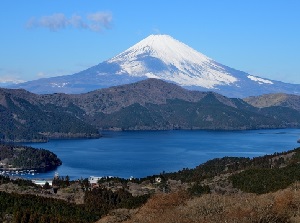
Lake Ashi in Hakone
Lake Biwa near Kyoto city is the largest lake in Japan and has an area of about 670 square kilometers.
It formed as the result of tectonic movement several million years ago.
The other lakes in Japan are very small.
Many of them are caldera lakes and dammed lakes by volcanic activity.
Popular Lake Ashi in Hakone is a caldera lake.
Lake Kawaguchi at the foot of Mt. Fuji is a dammed lake.
As there are many volcanoes in Japan, such lakes are dotted in the country.

